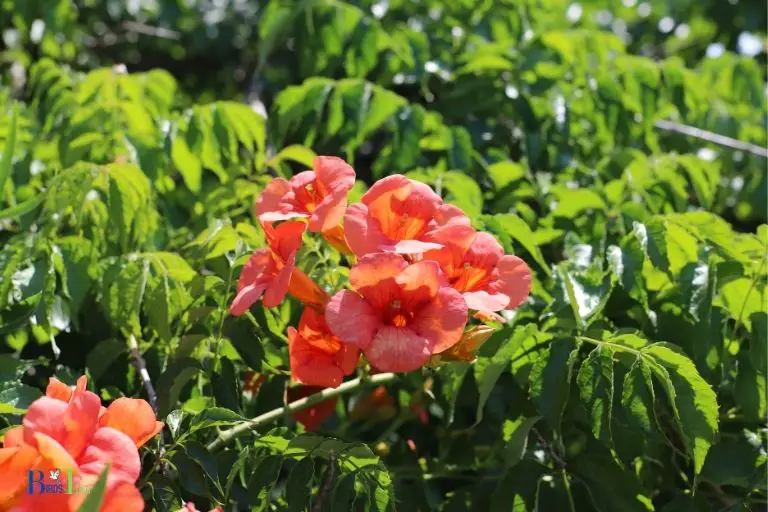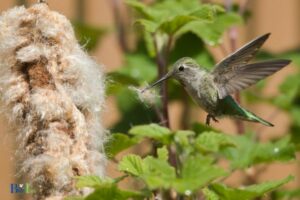How to Get Rid of Hummingbird Vine? 6 Effective Method!
To get rid of hummingbird vine, follow these steps: remove the vines manually, use herbicides, and practice proper garden maintenance.
Hummingbird vine, also known as trumpet vine (Campsis radicans), is a fast-growing, invasive plant that can quickly take over a garden if not properly managed.
It produces beautiful trumpet-shaped flowers that attract hummingbirds but can also damage structures, strangle other plants, and become difficult to control.
To effectively remove hummingbird vine, it’s essential to combine multiple removal methods and maintain your garden regularly to prevent its return.
Manually removing the hummingbird vine is an essential first step. Cut the vines near the ground level and carefully pull them out from surrounding plants and structures.
Be sure to dig up as much of the root system as possible, as the plant can regrow from the remaining roots.
Following manual removal, consider applying a selective herbicide to any remaining roots or shoots to eliminate the vine more effectively.
Regular garden maintenance, such as pruning and monitoring for new growth, can help prevent regrowth of the plant.
In areas with persistent hummingbird vine issues, you may need to install physical barriers like root barriers or landscape fabric to limit the vine’s ability to spread.
6 Effective Method to Get Rid of Hummingbird Vine
| Method | Description | Frequency | Duration |
|---|---|---|---|
| Mechanical removal | Uproot the entire plant, including roots to prevent regrowth. Best done when the soil is moist for easy removal. | As needed, when the vine is spotted | Immediate |
| Prune regularly | Keep the vines trimmed to control their growth. Prune new shoots as soon as they appear. | Weekly or biweekly, depending on growth rate | Ongoing |
| Mowing | If the vine is in a lawn area, keep it mowed to prevent it from spreading. | As needed, when the vine extends to the lawn | Ongoing |
| Smothering | Cut back the vine and cover it with a heavy black plastic sheet or thick layer of mulch to block sunlight and prevent regrowth. | As needed, when the vine is spotted | 4-6 weeks |
| Herbicides | Apply a systemic herbicide, like glyphosate, to the cut stems or foliage to kill the vine. Follow the product instructions carefully. | As needed, when the vine is spotted or resurges | Immediate |
| Biological control (introducing insects) | Introduce natural enemies of the vine, such as leaf beetles or larvae, that feed on the plant. However, consult an expert first. | As needed, in case of severe infestation | Varies |
Key Takeaway

Four Facts About Removing Hummingbird Vine
Understanding The Hummingbird Vine
Hummingbird vine is a species that grows wild in north and central america. It is an excellent addition to any garden, but it can quickly take over if it isn’t controlled. If you’re struggling to get rid of it, don’t worry – we have you covered.
In this blog post, we’ll help you understand this plant species and offer some tips on how to remove it permanently.
Introduction To The Hummingbird Vine Species:
Hummingbird vine is scientifically known as campsis radicans. It is a deciduous climber that produces vibrant flowers that hummingbirds adore.
Below are some key points you should know about hummingbird vine:
- It can grow up to 30 to 40 feet tall if not kept under control.
- Its flowers bloom from july to october.
- It produces orange-red flowers that attract hummingbirds.
- It’s commonly referred to as trumpet vine because of the shape of its flowers.
- Hummingbird vine is an invasive species, which means it can rapidly spread and damage other plant species in your garden.
Description Of How The Hummingbird Vine Grows:
The key to successful control of the hummingbird vine lies in understanding how it grows.
Below are some facts to keep in mind:
- Hummingbird vine grows best in well-drained soil and full sun to partial shade.
- It can grow in any soil type – sandy, loam or clay.
- It’s a fast-growing vine that spreads through runners (stolons) that can develop roots in a few weeks.
- It also produces seeds that can spread very quickly, so ensure you remove any seeds from flowers carefully.
If you want to control the spread of hummingbird vine, you should prune it regularly and remove any runners and seed pods before they produce new growth.
Make sure you dispose of them in a garbage bag; do not add them to your compost pile as they will grow back.
Hummingbird vine can be a beautiful addition to your garden. However, if left unchecked, it can quickly become a nuisance.
By understanding how the plant grows, you can take the necessary steps to prevent it from spreading and get rid of it entirely.
With the tips we’ve shared above, you should be well on your way to achieving a hummingbird vine-free garden in no time.
Factors That Drive The Growth Of Hummingbird Vine
Understanding The Environmental Factors That Contribute To The Growth Of The Hummingbird Vine
Hummingbird vine, also known as trumpet vine or campsis radicans, is a perennial climbing plant that can quickly take over gardens and landscapes if not controlled. Understanding the environmental factors that affect its growth can help you manage it better.
Some of the key factors that contribute to the growth of the hummingbird vine include:
- Sunlight: Trumpet vines thrive in full sun, which means they require at least 6 hours of direct sunlight per day to grow. They can tolerate partial shade, but this can result in slower growth and fewer blooms.
- Temperature: Hummingbird vine grows best in warm climates with long growing seasons and mild winters. It can grow well in usda zones 4 through 9.
- Moisture: While trumpet vines can tolerate dry conditions, they prefer moist, well-drained soils. Watering the plants regularly during dry spells can help keep the soil moist.
- Wind: Hummingbird vines are tolerant to wind and can even grow more vigorously in windy areas.
- Pollinator: As the name suggests, hummingbird vine is pollinated by hummingbirds. Attracting these birds to your garden or landscape can help the vines grow faster.
Soil Conditions That Favor The Growth Of The Hummingbird Vine
Hummingbird vines can grow in a variety of soil types, but they prefer well-drained soils that are rich in organic matter.
The following are some soil conditions that favor the growth of the hummingbird vine:
- Ph: Trumpet vines grow best in soils with a ph range of 6.0 to 7.5.
- Fertility: Hummingbird vines are heavy feeders and require nutrient-rich soils. Adding compost or well-rotted manure to the soil before planting can help provide the necessary nutrients.
- Texture: Trumpet vines can grow in soils with a variety of textures. However, they prefer loamy soils that are well-drained.
- Depth: Hummingbird vines have extensive root systems that can reach depths of up to 3 feet. They prefer soils that are deeper than 2 feet.
- Drainage: Poorly-drained soils can cause root rot and stunt the growth of trumpet vines. Ensuring that the soil is well-drained can help prevent these problems.
How To Identify Hummingbird Vine
Hummingbird vine is an invasive species of vine that can be difficult to get rid of, but identifying it is the first step. Unlike other vine types, hummingbird vine has unique physical characteristics that distinguish it.
In this section, we’ll go over how to identify hummingbird vine and the signs to watch out for when identifying it.
The Physical Characteristics That Distinguish Hummingbird Vine From Other Vine Types
Hummingbird vine has different physical characteristics that make it stand out from other vine types.
These include:
- Leaf shape: Hummingbird vine leaves are small and oval-shaped, with a pointed tip, giving them a unique heart shape that is different from other vine types.
- Flower color: This vine produces unique funnel-shaped flowers that come in shades of red, pink, and orange, resembling a hummingbird in flight, which is how it got its name.
- Size: Hummingbird vine has a relatively small size compared to other vine types, with stems that grow to about 20 feet long.
Signs To Watch Out For When Identifying Hummingbird Vine
When identifying hummingbird vine, there are specific signs you should look out for.
These include:
- Heart-shaped leaves: As mentioned earlier, the leaves of hummingbird vine have a unique heart shape, making them distinguishable from other vine types.
- Clusters of funnel-shaped flowers: Hummingbird vine flowers come in clusters that resemble a hummingbird in flight, making them easy to spot.
- Production of long stems: Hummingbird vine produces stems that grow to about 20 feet long, offering a branching network of foliage that climbs to heights.
Identifying hummingbird vine is the first step in getting rid of it. By knowing the physical characteristics and signs to watch out for, it’s easier to identify hummingbird vine from other vine types.
Remember to take action as soon as you identify the vine to prevent it from spreading further.
How To Get Rid Of Hummingbird Vine Naturally
Natural Methods Of Getting Rid Of Hummingbird Vine With Readily Available Home Products
Getting rid of hummingbird vine naturally is an effective and eco-friendly way to remove this pesky nuisance from your garden.
Here are some natural home products and methods you can use to get rid of the hummingbird vine:
- Vinegar solution: Mix a solution of equal parts vinegar and water in a spray bottle. Spray directly onto the hummingbird vine leaves and stems. The acidity of vinegar will weaken the vine, making it easier to pull out.
- Boiling water: Boil enough water to pour directly onto the hummingbird vine and the soil around it. This method will scorch the foliage, preventing it from growing back.
- Salt: Sprinkle salt directly onto the hummingbird vine from the base up to cover the roots and soil around them, making it impossible for the vine to grow back.
- Epsom salt: Mix a large amount of epsom salt with hot water and pour it carefully over the vine’s roots. As a natural herbicide, it will kill the roots of the hummingbird vine, preventing any future growth.
Best Practices When Getting Rid Of Hummingbird Vine:
When getting rid of the hummingbird vine, it’s important to follow best practices to ensure you remove it effectively.
Here are some tips you can follow:
- Wear protective gear: The hummingbird vine is known to cause skin irritation, and the sap can be harmful if ingested. Wear protective gear, including gloves, long sleeves, and pants, when handling the vine.
- Remove it completely: Ensure you remove every last bit of the hummingbird vine, including its roots. If any part of the vine is left behind, it will continue to grow.
- Dispose of it safely: Hummingbird vines are known to be invasive and harmful to native plants. Do not compost the vine or throw it in your yard waste. Instead, bag it and dispose of it in the trash.
- Use mulch: Once you have removed the hummingbird vine, use mulch to prevent any future growth. Cover the area with a thick layer of mulch, focusing on the edges, where the vine is most likely to grow back.
- Be persistent: The hummingbird vine is a tough plant to get rid of, and it may take multiple attempts to completely remove it from your garden. Be persistent and continue to try natural methods to get rid of it until it’s gone for good.
With these natural methods and best practices, you can effectively remove the hummingbird vine from your garden and prevent it from growing back. Happy gardening!
FAQ On Hummingbird Vine
How Do I Remove Hummingbird Vine From A Tree?
Can Vinegar Kill Hummingbird Vine?
How Do I Prevent Hummingbird Vine From Growing?
Does Hummingbird Vine Attract Hummingbirds?
Is Hummingbird Vine Poisonous?
Conclusion
As you can see, getting rid of hummingbird vine involves a bit of patience and effort. You can try using herbicides, but they may harm other plants. Alternatively, manual removal is more eco-friendly and precise.
Remember, preventing the vine from taking hold is easier than removing it later. So keep an eye on your garden and nip the vine in the bud. Also, try not to panic when dealing with invasive plants, since everyone faces this issue at some point.
With a calm mindset and the right tools, you can get rid of hummingbird vine and enjoy a beautiful garden full of vibrant blooms. Don’t let any pesky vines ruin your view and take the effort to get rid of them!






